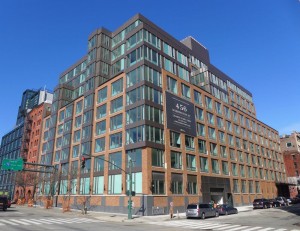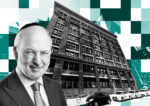Trending
Luxury rental throwdown: Q&A, part II
Douglas Elliman's Michael Graves and Halstead Property Development's Robin Schneiderman take their turns

From the June issue: After experiencing an incredible run-up in prices over the last five years, the NYC luxury rental market may be finally hitting a ceiling. All told, an estimated 8,000 rental units are entering the NYC market this year. They include the Durst Organization’s 750-unit starchitect project VIA 57 West at 625 West 57th Street, Related Companies’ 84-unit complex 456 Washington and Moinian Group’s Sky at 605 West 42nd Street, which will boast 1,175 apartments and 70,000 square feet of amenity space. Meanwhile, investors who bought condos at projects like One57 are adding to the luxury rental market.
In our second web installment, we turn to Michael Graves of Douglas Elliman and Robin Schneiderman of Halstead Property Development.
Michael Graves
Broker, Douglas Elliman
What are you seeing in terms of inventory compared to six months ago, a year ago and two years ago? Are you concerned about a rental glut?
I would not define it as a glut. It’s a healthy, gradual correction that will level out and then head back upwards. It’s not the floor falling out from under us. There has been a long pipeline of new developments that came to fruition recently and many were absorbed by investors. Now those investors are vying for the same tenants, which accounts for the competitive environment we are experiencing. We are also seeing record-setting offerings such as a unit at One57 currently asking $150,000 per month.
How long is it taking for luxury rental buildings to reach full occupancy? And what concessions, if any, are landlords offering in the luxury rental market these days?
It’s the prime rental season and I don’t expect to see wide-scale concessions across the board. However, some landlords have become more motivated and are willing to negotiate. I would say, if you have a 20-unit building, five rentals per month would be a target, or faster if you are pricing competitively.
Equity Residential said in February that its two- and three-bedroom units in Manhattan have become “more difficult to lease.” What are you seeing in terms of demand for each unit type?
I would expect that to be the case. As you climb the scale there is a smaller audience. And due to recent successful developments, that market is a bit more saturated now than it has been historically. In 2011-2013, developers discovered the large, high-level-finish condo market was underserved. Buildings like One57, 150 Charles and 56 Leonard opened the floodgates to similar product, which in turn has increased the current luxury offerings.
Where do you see rents for luxury apartments in Manhattan and Brooklyn going in the next six months? Will there be a recovery or do you see a continued decline? Which Manhattan or Brooklyn neighborhoods are seeing the biggest declines in rents?
The locations preferred by the international set will continue to do well, especially around the park. Wealthy foreigners coming from Asia and Europe want to be on the park, near shopping and other well-known attractions. I also believe that prime locations such as Tribeca, Soho, Gramercy, West Village and Chelsea will continue to do well. Meanwhile, the far Lower East Side, which is difficult to get to, will be the first to get hurt. Secondary locations that are not as accessible, that have not proven themselves to have legs over many years, may need to decrease asking prices. These could include the Far Upper East Side, Lower East Side, Chinatown and Harlem as well as outer boroughs. Locations that have recently been propped up by gentrification are most likely to revert.
What are the most surprising trends you’re seeing in the Manhattan and Brooklyn luxury rental market?
The amenity race, buildings offering larger and more creative amenity packages. That’s what we’re seeing amped up right now. A few years ago it was the golf simulator and in-house movie theater. Now it is indoor and outdoor pools, bowling alleys, teenage lounges and a variety of inventive work spaces, work-out facilities and decompression rooms. I suspect the trend will continue because that’s how developers compete.
Robin Schneiderman
Director of new business development, Halstead Property Development Marketing
Are you concerned about a rental glut?
I wouldn’t call it a glut. I would call it an increase at the very high end. There has been so much development in New York City over the last three years. There’s a lot of inventory in contract which is going to close this year and next year. Once that happens, we’ll get a better sense if there’s been a true increase in excessive luxury, units that rent for $10,000 per month and up.
How long is it taking for luxury rental buildings to reach full occupancy?
Depends on the number of units. You’d have to do a case study. Three hundred units could take six to 10 months. That’s 40 units per month during the busy season. The Brooklyn rental market has 11,000 rental units in the pipeline coming in the next two to three years, including both ground-up and conversion. Prime neighborhoods in Brooklyn include Williamsburg, Greenpoint, Cobble Hill, Boerum Hill, Dumbo, Brooklyn Heights, Park Slope and Downtown Brooklyn.
Aside from supply, are there any other market forces at play that account for the weaker demand for luxury rentals?
I’m most curious to see what will happen in Downtown Brooklyn and Long Island City. Those two neighborhoods alone have several thousand units coming online in coming years. You’re going to see a tremendous amount of units, a tremendous increase in new apartments in neighborhoods where this hasn’t happened before. They are going to compete against each other for new tenants and as a result, you are going to see a temporary reduction in rental prices. Then the market will stabilize. There will be a temporary reduction because they will all start their marketing and leasing at the same time, within a six-month window. Two Trees developments, Steiner Studios’ The Hub at 333 Schermerhorn Street, all three to six months of each other. For a period of time, they will have to offer concessions to lease up the buildings, but after that they’ll do fine. It’s a natural process when you have an increase in supply.
Are certain types of buildings doing better than others? Do older buildings struggle to compete with new developments?
Tenants in New York are always excited to live in a new building, to be the first ones to reside there. There’s a significant premium to live in a new building. One market that will probably see a pick-up in demand is the Upper East Side because of the Second Avenue subway. The additional transportation will help improve this market, which has always been a lagging rental market. You’re going to see more and more people consider it. And there’s been a tremendous amount of rental-to-condo conversions, which has reduced rental unit supply on the Upper East Side.
Brian Upbin
Head of asset management, Two Trees
What kind of monthly rents are you seeing in Brooklyn? How do those rents compare to a year ago and the recent past in general?
We continue to see strong demand and growth in monthly rents in the Brooklyn luxury rental market on a year-over-year basis. Our newest rental offering at 60 Water Street in DUMBO, which opened in late in 2014, has commanded the highest rents in the borough per square foot because of its incredible waterfront views and amenities, including a roof deck designed by James Corner Field Operations, while the rest of our Brooklyn rental portfolio has shown solid year-over-year gains and very high occupancy rates. We fully expect there to be strong demand for BAM South, our latest mixed-use project in Fort Greene, which includes market-rate and affordable rentals, slated to open later this year.
Are you concerned about a rental glut?
While this new supply coming on line will sharply expand the inventory to renters, we wouldn’t characterize this growth as a glut. We believe that the quality of product coming to market will attract a larger set of prospective renters to consider these areas.
How long is it taking for luxury rental buildings to reach full occupancy?
Many factors can affect the time it takes to reach full occupancy, including the number of units, the time of year and season when leasing begins and when the building first opens to residents moving in. We generally see rental buildings reaching full occupancy one full leasing season after construction has completed. TRD‘s interviews with Daniel Hollander, managing principal of DHA Capital, and Joshua Caspi, owner of Caspi Development, who weigh in on the condo and rental market and tell us what they think of Gary Barnett’s decision to market Extell’s One Manhattan Square condo project exclusively to Asian buyers.




